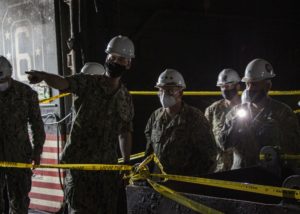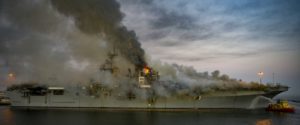All the fires on the USS Bonhomme Richard (LHD-6) were declared out by July 16, after four days of firefighting throughout the amphibious assault ship and with investigations set to take place before the Navy decides if it is worth maintaining the vessel.
Rear Adm. Philip E. Sobeck Commander, Expeditionary Strike Group Three, said on Thursday fire teams were checking every space in the ship to verify all fires were completely out, and official investigations would only start after that verification is complete.

“We did not know the origin of the fire. We do not know the extent of the damage. It is too early to make any predictions or promises of what the future of the ship will be. We cannot make any conclusions, until the investigation is complete,” Sobeck said in a statement.
He noted in addition to Federal Firefighters and Navy sailors from across San Diego three helicopter squadrons conducted more than 1,500 water bucket drops to help fire the fire, cool the super structure, and allow fire crew to get onboard to further fight the fire.
Tugs were also used for firefighting support below the waterline to help cool the ship’s hull.
During a Friday press conference in San Diego, Chief of Naval Operations Adm. Mike Gilday laid out his perspective of the extensive damage and detailed investigations to follow.
“As we move forward, there will be thorough investigations that will determine the next steps in a variety of areas. Make no mistake, we will follow the facts of what happened here, we’ll be honest with ourselves, and we’ll get after it as the Navy,” Gilday said.
He added he intends for the synchronized investigations to be made available to the public after they are completed.
First there will be a safety investigation, followed by a Navy Criminal Investigative Service to make sure there was no malfeasance at the root cause, and then a command investigation. The command investigation will look at several echelons to see if the right procedures are in place, personnel reacted correctly to the fire, if things should have been done differently, if the procedures were followed and sufficient for the situation.
Gilday said there will also be an assessment to examine the structural, electrical, and mechanical damage by experts from industry who built the ship, those who designed it, and Naval Sea Systems Command experts with experience with this kind of damage. Only after the assessments will the Navy judge whether the ship should be repaired.
The CNO also recounted what he saw when he went aboard LHD-6.
Gilday said he went four decks below the flight deck then up to the flight deck and saw the super structure. He said he was able to get a “good sense of the extent of the damage. And the damage is extensive. There is obviously electrical damage to the ship, there is structural damage to the ship and mechanical damage to the ship that we need to assess in much more detail before we make a final determination of next steps.”

The CNO said while he is 100 percent confident the defense industry can put the ship back to sea, “the question is should we make that investment in a 22-year-old ship. And I’m not going to make any predictions until we take a look at all the facts and we follow the facts and we can make reasoned recommendations up the chain of command on the future steps.”
Gilday said he was told on Monday one firefighter reported an internal ship temperature as high as 1,200 degrees.
He explained on the first day Navy officials thought they might have the fire out as early as Sunday night but were impeded by two factors: wind off the bay and a series of explosions.
Gilday said one explosion was reportedly heard 13 miles away and another blew debris on to another ship in the port. Therefore, the commanding officer pulled back firefighters at times for their safety.
“I think the situation was very tenuous. I think the commanding officer made some very sound decisions on how to attack the fire very deliberately.”
The LHD-6 fire started on July 12 while the ship was finishing a standard maintenance availability that would, among other things, make it capable of basing F-35B Joint Strike Fighters (Defense Daily, July 13).
On July 13, Sobeck said the first report of fire was on the lower V of the ship, where Marine Corps equipment is stored by the stern gate in the rear of the ship. It was being used as a storage area during the maintenance period and it appears to be where materials first ignited.
The Bonhomme Richard is the flagship of Expeditionary Strike Group Three. It was built by Huntington Ingalls Industries’ [HII] Ingalls Shipbuilding in Pascagoula, Miss., making it a likely option to repair the ship, if the Navy decides the vessel can be salvaged.
However, if LHD-6 is replaced, the Navy has switched to the new America-class LHA-6 amphibious assault ships, also built by HII. The Navy’s fiscal year 2021 budget request documents said it plans to procure LHA-9 in FY ’23 at a cost of $3.9 billion, not including advance procurement funds.